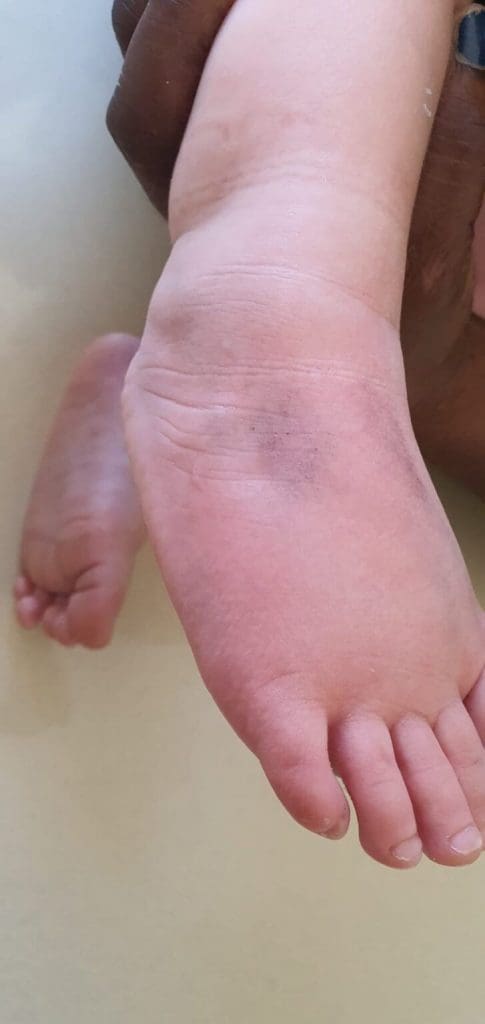
Is it a sprain or a fracture?
The child fell and hurt an arm or a leg. How can we tell if it’s a fracture or just a sprain? Should an X-ray be done, or is it acceptable to wait?
Let’s try to summarize a few general principles.
Please note that in this chapter, the focus is on limb injuries. A separate chapter discussing head injuries is available for you here.
Note the mechanism of injury:
The mechanism of injury is an extremely important concept in pediatrics and directly influences the decisions we make later.
For example, there’s a difference between a child who climbed a school fence and landed on concrete after a 3-meter fall, and a six-month-old who stumbled on a living room carpet.
This doesn’t mean the first child will necessarily suffer a fracture, nor that the second won’t get hurt — but the context matters.
If the mechanism of injury is significant, treat it with caution and seek a medical evaluation.
Note the local findings in the area of injury:
It’s difficult to give universal rules, but examine the injured area for key signs:
Look for deformity (an abnormal position), swelling, or bluish discoloration (which may indicate internal bleeding).
If there is an abnormal position or significant swelling, a proper medical check-up is required.
Note the movement of the limb after the injury and weight-bearing ability:
A fracture hurts. Even with an incomplete fracture, the child will typically avoid using the injured arm or leg, and movement will be very painful.
For leg injuries, a classic sign of fracture is the inability to bear weight. A child who is walking or running — even with a limp — is unlikely to have a fracture (though exceptions exist).
There have been cases where fractures were diagnosed days later after parents noticed their child holding an arm awkwardly or avoiding movement. So please, observe carefully, and if there is doubt, consult a doctor and consider an X-ray.
Notice the accompanying injuries:
While the focus here is on limb injuries, other injuries can occur.
Check that the child has not hurt their head and that they are moving all other limbs normally, aside from the one injured.
When to suspect a fracture?
A fracture should be suspected when a significant mechanism of injury is present, along with local signs and — most importantly — pain and reduced or absent movement of the limb.
In such cases, seek medical attention and get an X-ray.
Note that the wrist (carpal and forearm bones) can be a tricky area. Fractures here can be subtle and may take a few days to show on X-ray. Therefore, if there was a significant impact or tenderness in this area, it’s worth getting examined.
What is a sprain and when should it be suspected?
A sprain is an injury to a ligament or the joint capsule.
In children, sprains most often occur in the ankle, typically following a twisting injury. Sometimes a small “pop” is heard, and swelling usually appears, either on the outer or inner side of the ankle (over the bony bumps called the malleoli).
The swelling may be bluish in color, indicating bleeding.
There are three grades of sprains, ranging from a mild stretch to a full ligament tear (grade 3), which can result in joint instability.
Treatment typically includes pain relief and splinting with an elastic bandage.
If there is severe swelling, intense pain, or the child cannot bear weight, seek medical advice — this may not be a simple sprain.
Should we treat a child with painkillers after an injury, or will it “mask” the diagnosis?
If the child is injured and in pain, giving painkillers is acceptable.
That said, pay attention to the key signs mentioned above. In my opinion, painkillers will not obscure the important indicators of a fracture.
In injuries, should warm or cold compresses be used?
This is a common question and often causes confusion.
In the acute phase of an injury, when there may be internal bleeding, a cold compress can help by constricting blood vessels and reducing bleeding.
Later — for example, after about a day — when inflammation develops, warm compresses may help to reduce swelling and discomfort.
In conclusion, this is not a simple topic, as it’s difficult to provide universal answers — every injury is unique.
Still, I hope this chapter will be helpful if your child suffers with an injury.
For comments and questions, please register
